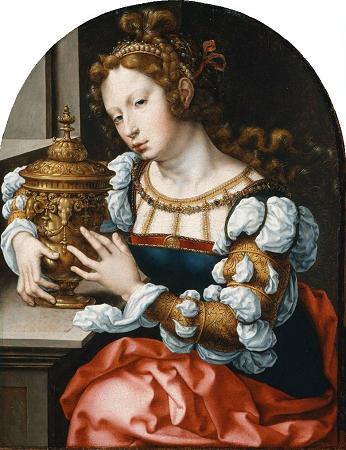Albrecht Durer (1471 - 1528). Albrecht Dürer, sometimes spelt in English as Durer or Duerer, without umlaut, was a German painter, printmaker, and theorist of the German Renaissance. Born in Nuremberg, Dürer established his reputation and influence across Europe when he was still in his twenties due to his high-quality woodcut prints. He was in communication with the major Italian artists of his time, including Raphael, Giovanni Bellini and Leonardo da Vinci, and from 1512 he was patronized by Emperor Maximilian I. Dürer is commemorated by both the Lutheran and Episcopal Churches. Dürer's vast body of work includes engravings, his preferred technique in his later prints, altarpieces, portraits and self-portraits, watercolours and books. The woodcuts, such as the Apocalypse series, are more Gothic than the rest of his work. His well-known engravings include the Knight, Death and the Devil, Saint Jerome in his Study and Melencolia I, which has been the subject of extensive analysis and interpretation. His watercolours also mark him as one of the first European landscape artists, while his ambitious woodcuts revolutionized the potential of that medium. Dürer's introduction of classical motifs into Northern art, through his knowledge of Italian artists and German humanists, has secured his reputation as one of the most important figures of the Northern Renaissance. This is reinforced by his theoretical treatises, which involve principles of mathematics, perspective, and ideal proportions. Albrecht Dürer has been credited with inventing the basic principle of ray tracing, a technique used in modern computer graphics. Dürer was born on 21 May 1471, third child and second son of his parents, who had at least fourteen and possibly as many as eighteen children. His father, Albrecht Dürer the Elder, was a successful goldsmith who in 1455 had moved to Nuremberg from Ajtós, near Gyula in Hungary. One of Albrecht's brothers, Hans Dürer, was also a painter and trained under him. Another of Albrecht's brothers, Endres Dürer, took over their father's business and was a master goldsmith. The German name Dürer is a translation from the Hungarian, Ajtósi. Initially, it was Türer, meaning doormaker, which is ajtós in Hungarian. A door is featured in the coat-of-arms the family acquired. Albrecht Dürer the Younger later changed Türer, his father's diction of the family's surname, to Dürer, to adapt to the local Nuremberg dialect. Dürer the Elder married Barbara Holper, daughter of his master when he himself qualified as a master in 1467. Dürer's godfather was Anton Koberger, who left goldsmithing to become a printer and publisher in the year of Dürer's birth, and became the most successful publisher in Germany, eventually owning twenty-four printing-presses and built a number of offices in Germany and abroad. Koberger's most famous publication was the Nuremberg Chronicle, published in 1493 in German and Latin editions. It contained an unprecedented 1,809 woodcut illustrations by the Wolgemut workshop. Dürer may have worked on some of these, as the work on the project began while he was with Wolgemut. Because Dürer left autobiographical writings and became very famous by his mid-twenties, his life is well documented by several sources. After a few years of school, Dürer started to learn the basics of goldsmithing and drawing from his father. Though his father wanted him to continue his training as a goldsmith, he showed such a precocious talent in drawing that he started as an apprentice to Michael Wolgemut at the age of fifteen in 1486. A self-portrait, a drawing in silverpoint, is dated 1484 when I was a child, as his later inscription says. Wolgemut was the leading artist in Nuremberg at the time, with a large workshop producing a variety of works of art, in particular woodcuts for books. Nuremberg was then an important and prosperous city, a centre for publishing and many luxury trades. It had strong links with Italy, especially Venice, a relatively short distance across the Alps.[ After completing his apprenticeship, Dürer followed the common German custom of taking Wanderjahre—in effect gap years—in which the apprentice learned skills from artists in other areas; Dürer was to spend about four years away. He left in 1490, possibly to work under Martin Schongauer, the leading engraver of Northern Europe, but who died shortly before Dürer's arrival at Colmar in 1492. It is unclear where Dürer travelled in the intervening period, though it is likely that he went to Frankfurt and the Netherlands. In Colmar, Dürer was welcomed by Schongauer's brothers, the goldsmiths Caspar and Paul and the painter Ludwig. In 1493 Dürer went to Strasbourg, where he would have experienced the sculpture of Nikolaus Gerhaert. Dürer's first painted self-portrait was painted at this time, probably to be sent back to his fiancée in Nuremberg. In early 1492 Dürer travelled to Basel to stay with another brother of Martin Schongauer, the goldsmith Georg. Very soon after his return to Nuremberg, on 7 July 1494, at the age of 23, Dürer was married to Agnes Frey following an arrangement made during his absence. Agnes was the daughter of a prominent brass worker in the city. However, no children resulted from the marriage, and with Albrecht the Dürer name died out. The marriage between Agnes and Albrecht was not a generally happy one, as indicated by the letters of Dürer in which he quipped to Willibald Pirckheimer in an extremely rough tone about his wife. He called her an old crow and made other vulgar remarks. Pirckheimer also made no secret of his antipathy towards Agnes, describing her as a miserly shrew with a bitter tongue, who helped cause Dürer's death at a young age. It is speculated by many scholars Albrecht was bisexual, if not homosexual, due to several of his works containing themes of homosexual desire, as well as the intimate nature of his correspondence with certain very close male friends.
more...














